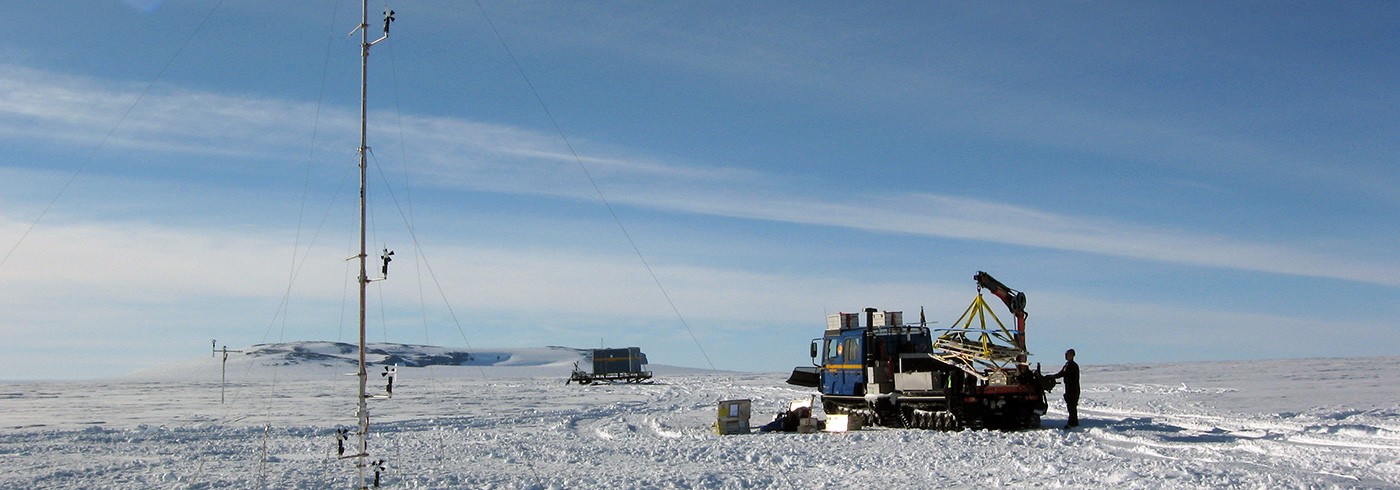UU/IMAU AWS in Dronning Maud Land, 2006/07 activities
1 November 2006 - 31 January 2007Since 1997/98 IMAU has been operating Automatic Weather Stations (AWS) in western Dronning Maud Land, of which one is situated close to Wasa (AWS 5) and another near Svea (AWS 6). The data from the stations have a wide range of applications, from model validation, energy balance and mass balance calculations to supporting logistic operations. Funding for the operation of the AWS is secured until 2012. Data from AWS 5 and 6 are also available on GTS (Global Telecommunication System, used by weather forecasters to collect meteorological data around the world) for weather forecasting and logistics purposes.
Fieldwork 2006/07
During the season 2006/07 the maintenance of AWS 5 and 6 was planned to concur with detailed meteorological measurements and an isotope diffusion experiment close to AWS 5. The AWS were visited by IMAU scientist Paul Smeets, supported by personnel and vehicles from the Swedish Polar Research Secretariat (picture 1). The AWS memory modules were exchanged, battery packs replaced and the masts extended. The wind and temperature/humidity sensors were replaced and new snow temperature sensors were placed at depths of 0.05, 0.1, 0.2, 0.4 and 0.8 m below the surface (picture 1).
As well as the regular maintenance of the AWS, additional experiments were performed close to AWS 5 to aid interpretation of the AWS data. During the field work an 11 m high profile mast with 6 level wind speed and 5 level temperature measurements was installed close to AWS 5 by IMAU scientist Paul Smeets and personnel from the Swedish Polar Research Secretariat (picture 2). A turbulence sensor (sonic anemometer) was mounted at AWS 5 to record year-round eddy correlation measurements. A similar set-up of meteorological measurements was run during the same period by personnel of the Finnish Meteorological Institute and the University of Helsinki (i.e. Timo Vihma and Roberta Pirazzini) close to Basen and benefiting from mutual interests and collaboration, IMAU scientist Paul Smeets was housed during the fieldwork at the nearby Finnish station Aboa. Combining a profile mast and a turbulence sensor enables a detailed study of the lower 10% of the Atmospheric Boundary Layer (ABL), the so-called surface layer (SL). For the isotope diffusion experiment a layer of isotopically-enriched snow was sprayed on top of the actual snow cover in a controlled fashion in a small field (6 × 6 m) marked with stakes close to AWS 5. After deposition the isotopic peak signal of the artificial snow is gradually damped over the years as a consequence of isotope diffusion in firn. Drilling a small core at regular intervals in the years to come will enable us to study the temporal diffusion of this layer into the firn (picture 2).
Throughout the season, location AWS 5 was visited on a regular basis to collect data, check the equipment or perform experiments. A safe and comfortable stay was ensured by the small shelter (picture 2) erected by personnel of the Swedish Polar Research Secretariat. The Swedish Polar Research Secretariat also facilitated transport between Wasa and AWS 5 of all the equipment for the experiments.
Some results
AWS 5 and 6 are the most reliable IMAU AWS because persistent katabatic winds prevent ice accretion. The data retrieved from both AWS showed continuous time series without any flaws. As a result, nearly continuous measurement sequences are now available dating from the beginning of 1998, i.e. covering about 9 years. As an example, figure 1 shows the hourly means of wind speed and temperature from AWS 6. The clear annual cycle in temperature is also reflected in the wind speed signal, with higher values during winter. In winter we also observe the largest temperature variations. Periods with low wind speeds are associated with a large negative long wave radiation deficit and hence low temperatures. When the wind speed is high, downward mixing of warmer air from higher altitudes results in much higher temperatures. During summer, continuous incoming short wave radiation partially compensates the long wave radiation deficit, giving rise to much less temperature variability. In figure 2 we show preliminary results for sensible heat fluxes derived from the sonic anemometer and plotted against those calculated from the AWS data. The data shown were obtained during fair weather periods and line up nicely along the 1:1 line. However, more detailed observation reveals a small offset when the fluxes are small. This disagreement necessitates further study of the combined data from AWS, the profile mast, and sonic anemometer.
Data availability
The AWS data are available for research purposes free of charge (certain conditions apply when data are used in publications: contact Michiel van de Broeke). Those interested in working with the data should contact Michiel van den Broeke, Carleen Reijmer or Paul Smeets.





